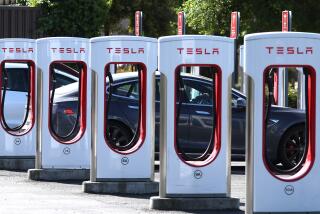Keeping a green eye on drivers
DENVER — Hundreds of drivers here will serve as guinea pigs in a test that’s part sociology experiment, part environmental advocacy and part Driver’s Ed 101.
It poses the question: When motorists see how their own aggressive driving burns gasoline, will they stop the tailgating, hard braking and speeding that increases their fuel consumption and contributes to greenhouse gas emissions?
Sponsored by EnCana Corp., the pilot program aims to quantify the relationship between bad driving and gas emissions, as well as to persuade drivers to change. Denver is the first test site.
“People will modify their behavior,” predicted Larry Goldenhersh, president and chief executive of Enviance, a California-based company that developed the software for the program. “Frankly, the prospect of having this thing in my car has already modified my behavior.”
Four hundred people -- 200 in the city fleet and 200 volunteers -- will have accelerometers installed in their vehicles that record every time they slam on their brakes, rapidly accelerate or take a corner too quickly.
Such behaviors decrease fuel efficiency 20%, Goldenhersh said. The goal of the program is to reduce emissions from each participating vehicle 20%.
Once the devices are installed, participants can visit a website and track how they’re doing. In addition, monitors will be installed on the cars to give drivers real-time feedback, said David Armitage, chief executive of Denver-based Cartasite Inc., which manufactured the accelerators.
Rapid acceleration wastes fuel because it floods the engine with extra gas, causing the car to burn the excess. And when a driver rides the brake unnecessarily, the energy that was used to get the car up to speed has been lost.
“The slower we stop the car, the less energy we’re throwing away,” Armitage said.
Losing less energy to starts and stops is one reason cars tend to get better mileage on highways.
“You can’t change what you can’t measure,” Armitage said. If drivers don’t see the connection between their actions and the consequences, “we’re not going to make a change.”
Armitage said that when he started tracking his own driving, he noticed he braked suddenly more often than he realized. That’s because he tended to glance at his BlackBerry while he drove, a habit he’s since cut out, he said.
One volunteer is Denver Mayor John Hickenlooper, who offered to put his own Ford hybrid and driving skills to the test.
“I lobbied for this. I thought it was such a great idea,” said Hickenlooper, who’s hopeful his tracking device won’t reveal too many bad habits. “My mother made me take defensive driving back in high school. I’m from the old school.”
Another participant is Suzanne Gaylor, 31, a controller for a real estate development firm, who said she volunteered out of her concern for environmental issues.
“I do think every bit counts,” she said.
She suspects the theory will prove correct that given data about themselves, drivers will seek to improve.
“With my personality, I think I’d be a person who logs on daily,” she said. “You would get kind of competitive with yourself, especially at the beginning when you see these alarming statistics about the way you drive.”
Ultimately, such efforts might help reduce Denver’s carbon emissions, given that vehicles account for about 30%, Goldenhersh said.
Changing people’s driving behavior isn’t the only solution to addressing greenhouse gas emissions, but it’s one of them, Armitage said.
“We’re stuck with the infrastructure we have,” he said. “We need more effective mass transit. We need to do a better job of carpooling. We need to be thinking about driving less. This is part of a matrix of things we can do.”
--






